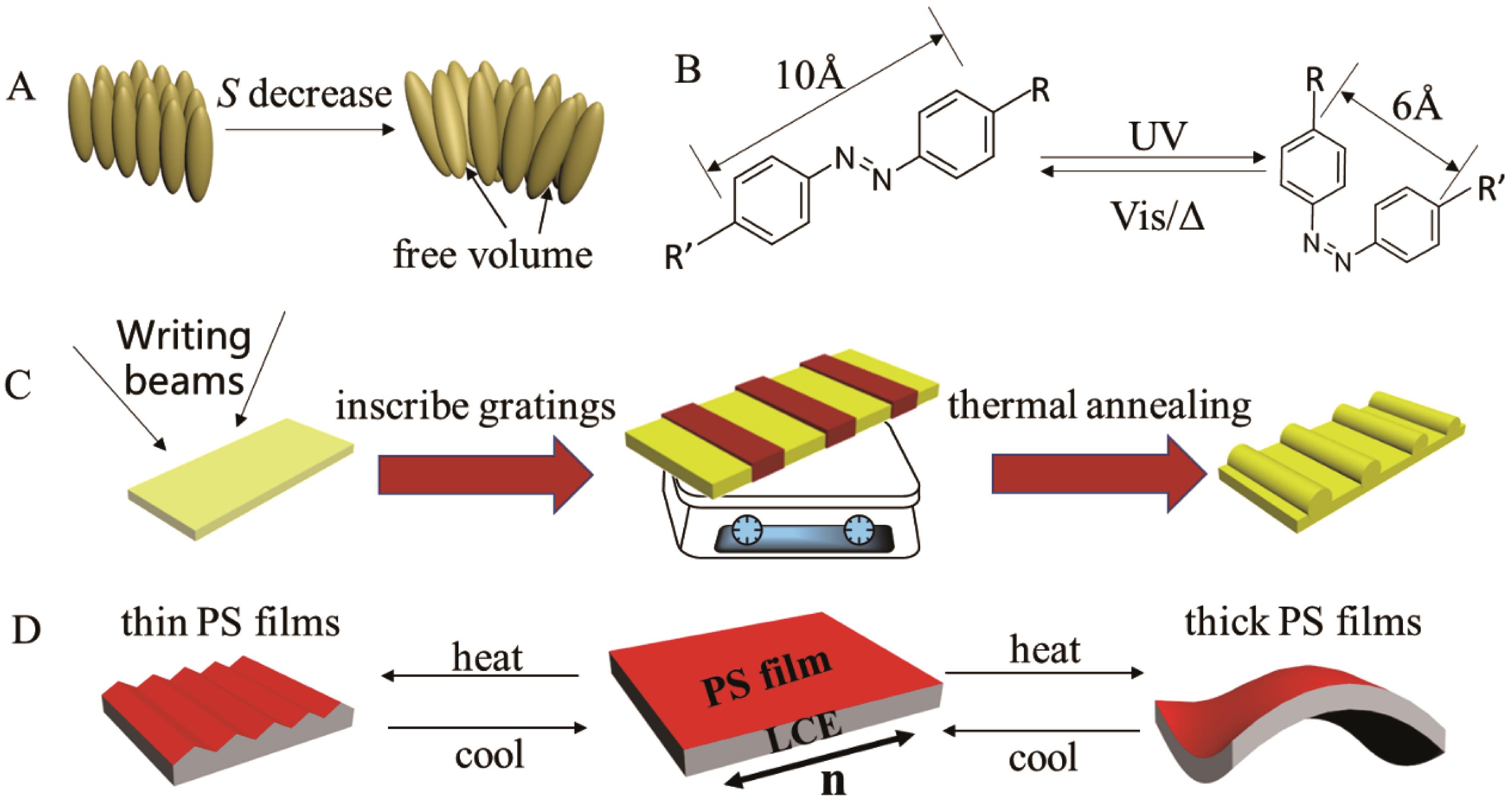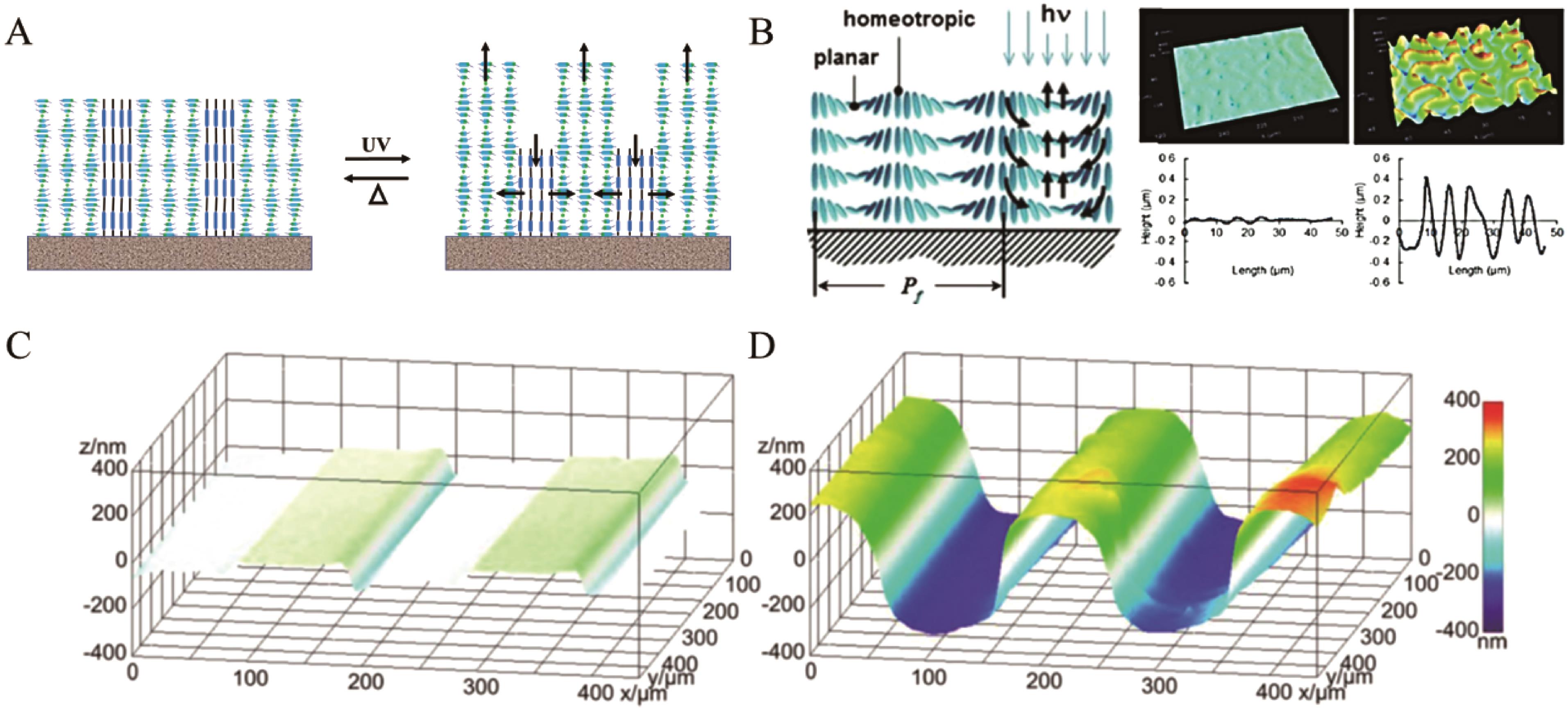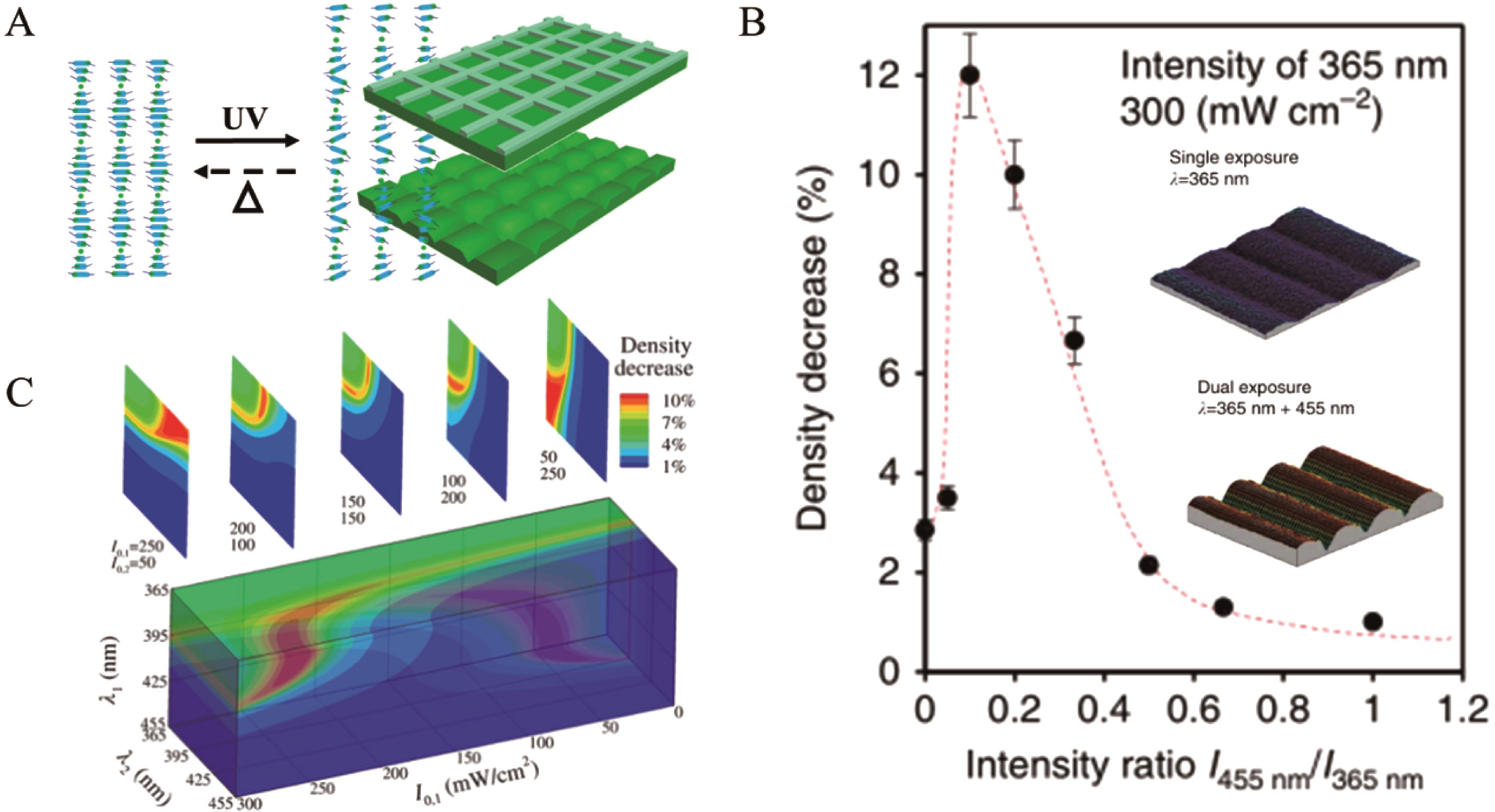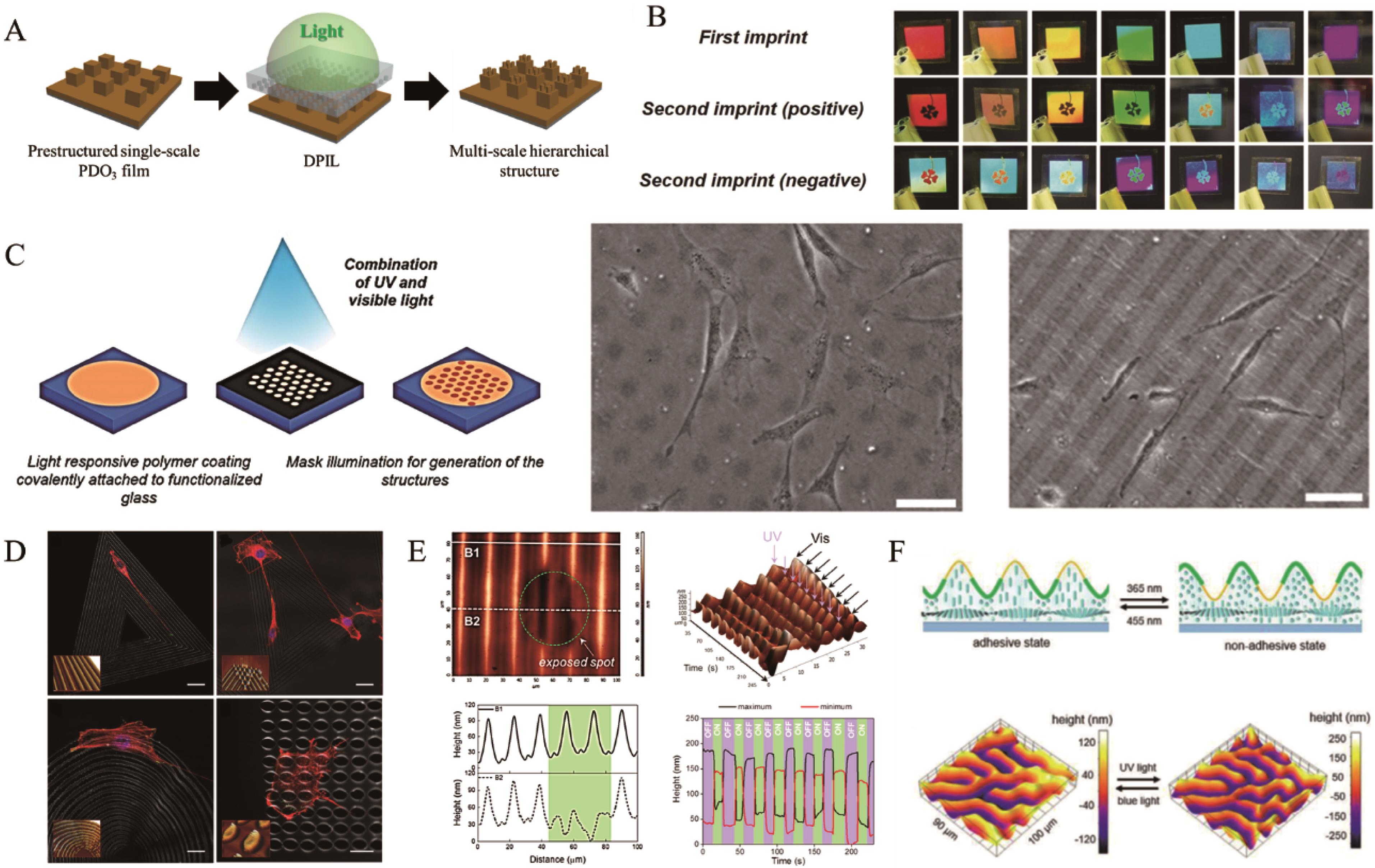
Chinese Journal of Applied Chemistry ›› 2021, Vol. 38 ›› Issue (10): 1226-1237.DOI: 10.19894/j.issn.1000-0518.210381
• Review • Previous Articles Next Articles
Research Progress on Photoswitchable Surface Topography of Liquid Crystalline Polymer
Yu-Fan JI, Feng CAI, Hai-Feng YU( )
)
- School of Materials Science and Engineering,and Key Laboratory of Polymer Chemistry and Physics of Ministry of Education,Peking University,Beijing 100871,China
-
Received:2021-07-30Accepted:2021-08-26Published:2021-10-01Online:2021-10-15 -
Contact:Hai-Feng YU -
About author:yuhaifeng@pku.edu.cn
-
Supported by:National Natural Science Foundation of China(51773002)
CLC Number:
Cite this article
Yu-Fan JI, Feng CAI, Hai-Feng YU. Research Progress on Photoswitchable Surface Topography of Liquid Crystalline Polymer[J]. Chinese Journal of Applied Chemistry, 2021, 38(10): 1226-1237.
share this article
Add to citation manager EndNote|Ris|BibTeX
URL: http://yyhx.ciac.jl.cn/EN/10.19894/j.issn.1000-0518.210381

Fig.1 (A) The change induced by the decreased order parameter; (B) Photo-isomerization of azobenzene; (C) The formation process of surface relief gratings; (D) Two instability modes of bilayer membrane

Fig.2 (A) LCN containing chiral nematic and homeotropic orientation. After ultraviolet (UV) illumination, the chiral nematic areas expand perpendicular to the plane of the film while the homeotropic areas contract in the perpendicular direction; (B) LCN including fingerprint patterns. Images from interferometer measurements showing the surface topography before and during UV irradiation[40]; Topographical deformation of LCN coatings with (C) rigid glass and (D) a compliant polymer layer as the substrate[41]

Fig.3 (A) Illustration of the reduced LCN density after UV illumination with photomasks due to the generation of free volume; (B) Under the illumination of 365 and 455 nm light, surface topographical deformation is increased[21]; (C) Design box for maximizing the optomechanical response under two-light illumination with arbitrary wavelengths[45]

Fig.4 (A,B) Surface reliefs resulting from linearly (A) and circularly (B) polarized beams[49]; (C) Scheme of the influence of q value on spiral pattern; (D,E) Optical micrograph and AFM image of the pattern of q=10 (D) and q= -10 (E) L-G beam. All the scale bars are 1 μm[51]; (F,G) Manipulation of surface topography using dichroic dye (F) and dichroic initiator (G) during polymerization

Fig.5 Optical microscopic images of the surface topography without (A) and with (B) 436 nm linearly polarized light irradiation; (C) Scheme of the macroscopic wrinkle formation of the PDMS surface by the UV-curable LCP film containing azobenzene-containing photoinitiator[56]; Optical microscopic images of wrinkle topography under UV illumination when uniaxial compression is parallel (D) and perpendicular (E) to the line pattern[57]; (F) Multiple cycles of stimulus-induced wrinkling, light-induced tuning and erasing in the optically wrinkling system[58]

Fig.6 (A) Schematic illustration of the fabrication of complex hierarchical multilevel structures; (B) Structural color images of imprinted nanopatterns[65]; (C) Schematic process of the surface topography change on the light-responsive LCE coatings and phase contrast images of NIH-3T3 cells on patterned LCN in hexagonally arranged pillars of 0.2 μm height and a circular pattern with a height of 0.3 μm. Scale bars are 50 μm[67]; (D) Cell orientation on confocal-induced pDR1m patterns including the geometry along the sides, on the vertex, on concentric rings and on array of dots. Scale bars are 10 μm[68] ; (E) AFM images of surface topography of the HH-perpendicular structure which is UV photostationary state and locally exposed to green light. Surface waving happens under the continuous UV illumination and alternative green light[69] ; (F) Schematic illustration of the switch of adhesion via light-triggered topographical deformation and 3D digital holographic microscopic images of the surface topographical inversion during the light stimulation process[70]
| 1 | OSCURATO S L, BORBONE F, MADDALENA P, et al. Light-driven wettability tailoring of azopolymer surfaces with reconfigured three-dimensional posts[J]. ACS Appl Mater Interfaces, 2017, 9(35): 30133-30142. |
| 2 | LIU D Q, TITO N B, BROER D J. Protruding organic surfaces triggered by in-plane electric fields[J]. Nat Commun, 2017, 8: 1526. |
| 3 | FENG W, BROER D J, LIU D Q. Oscillating chiral-nematic fingerprints wipe away dust[J]. Adv Mater, 2018, 30(11): 1704970. |
| 4 | VISWANATHAN N K, KIM D Y, BIAN S P, et al. Surface relief structures on azo polymer films[J]. J Mater Chem, 1999, 9(9): 1941-1955. |
| 5 | NATANSOHN A, ROCHON P. Photoinduced motions in azo-containing polymers[J]. Chem Rev, 2002, 102(11): 4139-4175. |
| 6 | FUKUDA T, MATSUDA H, SHIRAGA T, et al. Photofabrication of surface relief grating on films of azobenzene polymer with different dye functionalization[J]. Macromolecules, 2000, 33(11): 4220-4225. |
| 7 | VISSCHERS F L L, HENDRIKX M, ZHAN Y Y, et al. Liquid crystal polymers with motile surfaces[J]. Soft Matter, 2018, 14(24): 4898-4912. |
| 8 | LIU D, BROER D J. Liquid crystal polymer networks: switchable surface topographies[J]. Liq Cryst Rev, 2013, 1(1): 20-28. |
| 9 | FENG W, LIU D, BROER D J. Functional liquid crystal polymer surfaces with switchable topographies[J]. Small Struct, 2021, 2(1): 2000107. |
| 10 | LIU D Q, BASTIAANSEN C W M, DEN TOONDER J M J, et al. (Photo-)Thermally induced formation of dynamic surface topographies in polymer hydrogel networks[J]. Langmuir, 2013, 29(18): 5622-5629. |
| 11 | WANG Z, HANSEN C, GE Q, et al. Programmable, pattern-memorizing polymer surface[J]. Adv Mater, 2011, 23(32): 3669-3673. |
| 12 | KONG X, WANG X, LUO T, et al. Photomanipulated architecture and patterning of azopolymer array [J]. ACS Appl Mater Interfaces, 2017, 9(22): 19345-19353. |
| 13 | YANG B, YU M, YU H. Azopolymer-based nanoimprint lithography: recent developments in methodology and applications[J]. ChemPlusChem, 2020, 85(9): 2166-2176. |
| 14 | TURIV T, KRIEGER J, BABAKHANOVA G, et al. Topology control of human fibroblast cells monolayer by liquid crystal elastomer[J]. Sci Adv, 2020, 6(20): eaaz6485. |
| 15 | LIU L, BROER D J, ONCK P R. Travelling waves on photo-switchable patterned liquid crystal polymer films directed by rotating polarized light[J]. Soft Matter, 2019, 15(40): 8040-8050. |
| 16 | MEHTA K, PEEKETI A R, LIU L, et al. Design and applications of light responsive liquid crystal polymer thin films[J]. Appl Phys Rev, 2020, 7(4): 041306. |
| 17 | HIKMET R A M, BROER D J. Dynamic mechanical properties of anisotropic networks formed by liquid crystalline acrylates[J]. Polymer, 1991, 32(9): 1627-1632. |
| 18 | VAN OOSTEN C L, HARRIS K D, BASTIAANSEN C W M, et al. Glassy photomechanical liquid-crystal network actuators for microscale devices[J]. Eur Phys J E, 2007, 23(3): 329-336. |
| 19 | MOL G N, HARRIS K D, BASTIAANSEN C W M, et al. Thermo-mechanical responses of liquid-crystal networks with a splayed molecular organization[J]. Adv Funct Mater, 2005, 15(7): 1155-1159. |
| 20 | TANCHAK O M, BARRETT C J. Light-induced reversible volume changes in thin films of azo polymers: the photomechanical effect[J]. Macromolecules, 2005, 38(25): 10566-10570. |
| 21 | LIU D Q, BROER D J. New insights into photoactivated volume generation boost surface morphing in liquid crystal coatings[J]. Nat Commun, 2015, 6: 8334. |
| 22 | HUGEL T, HOLLAND N B, CATTANI A, et al. Single-molecule optomechanical cycle[J]. Science, 2002, 296(5570): 1103-1106. |
| 23 | HOLLAND N B, HUGEL T, NEUERT G, et al. Single molecule force spectroscopy of azobenzene polymers: switching elasticity of single photochromic macromolecules[J]. Macromolecules, 2003, 36(6): 2015-2023. |
| 24 | LI C, CAO L, LI J, et al. Improvement of volume holographic performance by plasmon-induced holographic absorption grating[J]. Appl Phys Lett, 2013, 102(6): 061108. |
| 25 | BRUDER F K, HAGEN R, RÖLLE T, et al. From the surface to volume: concepts for the next generation of optical⁃holographic data-storage materials[J]. Angew Chem Int Ed, 2011, 50(20): 4552-4573. |
| 26 | CHO Y H, SHIN C W, KIM N, et al. High-performance transmission holographic gratings via different polymerization rates of dipentaerythritol acrylates and siloxane-containing epoxides[J]. Chem Mater, 2005, 17(25): 6263-6271. |
| 27 | GOLDENBERG L M, SAKHNO O V, SMIRNOVA T N, et al. Holographic composites with gold nanoparticles: nanoparticles promote polymer segregation[J]. Chem Mater, 2008, 20(14): 4619-4627. |
| 28 | YU H F, OKANO K, SHISHIDO A, et al. Enhancement of surface-relief gratings recorded on amphiphilic liquid-crystalline diblock copolymer by nanoscale phase separation[J]. Adv Mater, 2005, 17(18): 2184-2188. |
| 29 | AN N, LI M E, ZHOU J X. Instability of liquid crystal elastomers[J]. Smart Mater Struct, 2016, 25(1): 015016. |
| 30 | SONI H, PELCOVITS R A, POWERS T R. Wrinkling of a thin film on a nematic liquid-crystal elastomer[J]. Phys Rev E, 2016, 94(1): 012701. |
| 31 | ROFOUIE P, PASINI D, REY A D. Nano-scale surface wrinkling in chiral liquid crystals and plant-based plywoods[J]. Soft Matter, 2015, 11(6): 1127-1139. |
| 32 | SONG S E, CHOI G H, YI G R, et al. Competitive concurrence of surface wrinkling and dewetting of liquid crystalline polymer films on non-wettable substrates[J]. Soft Matter, 2017, 13(42): 7753-7759. |
| 33 | KANG S H, NA J H, MOON S N, et al. Self-organized anisotropic wrinkling of molecularly aligned liquid crystalline polymer[J]. Langmuir, 2012, 28(7): 3576-3582. |
| 34 | AGRAWAL A, YUN T, PESEK S L, et al. Shape-responsive liquid crystal elastomer bilayers[J]. Soft Matter, 2014, 10(9): 1411-1415. |
| 35 | ZHAO S, XU F, FU C, et al. Controllable wrinkling patterns on liquid crystal polymer film/substrate systems by laser illumination [J]. Extreme Mech Lett, 2019, 30: 100502. |
| 36 | LIU X, LIU Y. Spontaneous photo-buckling of a liquid crystal elastomer membrane[J]. Int J Mech Sci, 2021, 201: 106473. |
| 37 | ZHAO J, YU Y, XU P, et al. Wrinkling of liquid-crystal elastomer disks caused by light-driven dynamic contraction[J]. Phys Rev E, 2021, 103(4): L041002. |
| 38 | LIU D Q, BASTIAANSEN C W M, DEN TOONDER J M J, et al. Photo-switchable surface topologies in chiral nematic coatings[J]. Angew Chem Int Ed, 2012, 51(4): 892-896. |
| 39 | BROER D J, MOL G N. Anisotropic thermal-expansion of densely cross-linked oriented polymer networks[J]. Polym Eng Sci, 1991, 31(9): 625-631. |
| 40 | LIU D Q, BROER D J. Self-assembled dynamic 3D fingerprints in liquid-crystal coatings towards controllable friction and adhesion[J]. Angew Chem Int Ed, 2014, 53(18): 4542-4546. |
| 41 | HENDRIKX M, SIRMA B, SCHENNING A P H J, et al. Compliance-mediated topographic oscillation of polarized light triggered liquid crystal coating[J]. Adv Mater Interfaces, 2018, 5(20): 1800810. |
| 42 | HENDRIKX M, SCHENNING A P H J, BROER D J. Patterned oscillating topographical changes in photoresponsive polymer coatings[J]. Soft Matter, 2017, 13(24): 4321-4327. |
| 43 | EISENBACH C D. Effect of polymer matrix on the cis⁃trans isomerization of azobenzene residues in bulk polymers[J]. Makromol Chem, 1978, 179(10): 2489-2506. |
| 44 | LIU D Q, BASTIAANSEN C W M, DEN TOONDER J M J, et al. Light-induced formation of dynamic and permanent surface topologies in chiral-nematic polymer networks[J]. Macromolecules, 2012, 45(19): 8005-8012. |
| 45 | LIU L, ONCK P R. Enhanced deformation of azobenzene-modified liquid crystal polymers under dual wavelength exposure: a photophysical model[J]. Phys Rev Lett, 2017, 119(5): 057801. |
| 46 | ROCHON P, BATALLA E, NATANSOHN A. Optically induced surface gratings on azoaromatic polymer-films[J]. Appl Phys Lett, 1995, 66(2): 136-138. |
| 47 | KIM D Y, TRIPATHY S K, LI L, et al. Laser-induced holographic surface-relief gratings on nonlinear-optical polymer-films[J]. Appl Phys Lett, 1995, 66(10): 1166-1168. |
| 48 | OSCURATO S L, SALVATORE M, MADDALENA P, et al. From nanoscopic to macroscopic photo-driven motion in azobenzene-containing materials[J]. Nanophotonics, 2018, 7(8): 1387-1422. |
| 49 | BIAN S, LI L, KUMAR J, et al. Single laser beam-induced surface deformation on azobenzene polymer films[J]. Appl Phys Lett, 1998, 73(13): 1817-1819. |
| 50 | BIAN S, WILLIAMS J M, KIM D Y, et al. Photoinduced surface deformations on azobenzene polymer films[J]. J Appl Phys, 1999, 86(8): 4498-4508. |
| 51 | AMBROSIO A, MARRUCCI L, BORBONE F, et al. Light-induced spiral mass transport in azo-polymer films under vortex-beam illumination[J]. Nat Commun, 2012, 3: 989. |
| 52 | AMBROSIO A, MADDALENA P, MARRUCCI L. Molecular model for light-driven spiral mass transport in azopolymer films[J]. Phys Rev Lett, 2013, 110(14): 146102. |
| 53 | FENG W, BROER D J, GREBIKOVA L, et al. Static and dynamic control of fingerprint landscapes of liquid crystal network coatings[J]. ACS Appl Mater Interfaces, 2020, 12(5): 5265-5273. |
| 54 | YANG D, HE L H. Photo-triggered wrinkling of glassy nematic films[J]. Smart Mater Struct, 2014, 23(4): 045012. |
| 55 | YANG D, HE L H. Nonlinear analysis of photo-induced wrinkling of glassy twist nematic films on compliant substrates[J]. Acta Mech Sin, 2015, 31(5): 672-678. |
| 56 | YAMAOKA D, HARA M, NAGANO S, et al. Photoalignable radical initiator for anisotropic polymerization in liquid crystalline media[J]. Macromolecules, 2015, 48(4): 908-914. |
| 57 | TAKESHIMA T, LIAO W, NAGASHIMA Y, et al. Photoresponsive surface wrinkle morphologies in liquid crystalline polymer films[J]. Macromolecules, 2015, 48(18): 6378-6384. |
| 58 | ZONG C Y, ZHAO Y, JI H P, et al. Tuning and erasing surface wrinkles by reversible visible-light-induced photoisomerization[J]. Angew Chem Int Ed, 2016, 55(12): 3931-3935. |
| 59 | PRIIMAGI A, SHEVCHENKO A. Azopolymer-based micro- and nanopatterning for photonic applications[J]. J Polym Sci, Part B: Polym Phys, 2014, 52(3): 163-182. |
| 60 | KIM K, PARK H, PARK K J, et al. Light-directed soft mass migration for micro/nanophotonics[J]. Adv Opt Mater, 2019, 7(16): 1900074. |
| 61 | FEDELE C, NETTI P A, CAVALLI S. Azobenzene-based polymers: emerging applications as cell culture platforms[J]. Biomater Sci, 2018, 6(5): 990-995. |
| 62 | CHOI J, CHO W, JUNG Y S, et al. Direct fabrication of micro/nano-patterned surfaces by vertical-directional photofluidization of azobenzene materials[J]. ACS Nano, 2017, 11(2): 1320-1327. |
| 63 | KANG H S, LEE S, LEE S A, et al. Multi-level micro/nanotexturing by three-dimensionally controlled photofluidization and its use in plasmonic applications[J]. Adv Mater, 2013, 25(38): 5490-5497. |
| 64 | KANG H S, KIM H T, PARK J K, et al. Light-powered healing of a wearable electrical conductor[J]. Adv Funct Mater, 2014, 24(46): 7273-7283. |
| 65 | YANG B, CAI F, HUANG S, et al. Athermal and soft multi-nanopatterning of azopolymers: phototunable mechanical properties[J]. Angew Chem Int Ed, 2020, 59(10): 4035-4042. |
| 66 | LIU Y, LIANG S, YUAN C, et al. Fabrication of anticounterfeiting nanocomposites with multiple security features via integration of a photoresponsive polymer and upconverting nanoparticles[J]. Adv Funct Mater, 2021, 2103908. |
| 67 | KOÇER G, TER SCHIPHORST J, HENDRIKX M, et al. Light-responsive hierarchically structured liquid crystal polymer networks for harnessing cell adhesion and migration[J]. Adv Mater, 2017, 29(27): 1606407. |
| 68 | RIANNA C, ROSSANO L, KOLLARIGOWDA R H, et al. Spatio-temporal control of dynamic topographic patterns on azopolymers for cell culture applications[J]. Adv Funct Mater, 2016, 26(42): 7572-7580. |
| 69 | RYABCHUN A, LANCIA F, KATSONIS N. Light-fueled nanoscale surface waving in chiral liquid crystal networks[J]. ACS Appl Mater Interfaces, 2021, 13(3): 4777-4784. |
| 70 | FENG W, CHU L, DE ROOIJ M B, et al. Photoswitching between water-tolerant adhesion and swift release by inverting liquid crystal fingerprint topography[J]. Adv Sci, 2021, 8(8): 2004051. |
| 71 | FEDELE C, DE GREGORIO M, NETTI P A, et al. Azopolymer photopatterning for directional control of angiogenesis[J]. Acta Biomater, 2017, 63: 317-325. |
| [1] | Long-Fei LUO, Yu-Jie LI, Zhi-Hao SHEN, Shi-Jun ZHENG, Xing-He FAN. Progress in Self⁃assembly and Photo⁃responsiveness of Thin Films of Azobenzene⁃Based Liquid Crystalline Block Copolymers [J]. Chinese Journal of Applied Chemistry, 2021, 38(10): 1238-1254. |
| [2] | He Jiasong. ON THE IN-SITU COMPOSITES REINFORCED BY FIBRILS OF THERMOTROPIC LIQUID CRYSTALLINE POLYMERS [J]. Chinese Journal of Applied Chemistry, 1993, 0(5): 43-47. |
| [3] | Yang Chuncai, Feng Guizhen, Zhang Wanjin Huang Zhinua, Tang Xinyi, Zhao Xiaoguang, Zhou Enle. SYNTHESIS OF SIDE-CHAIN LIQUID CRYSTALLINE POLYMERS BY POLYCONDENSATION+ [J]. Chinese Journal of Applied Chemistry, 1992, 0(5): 116-119. |
| Viewed | ||||||
|
Full text |
|
|||||
|
Abstract |
|
|||||